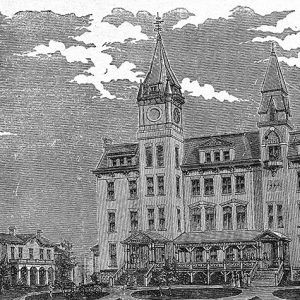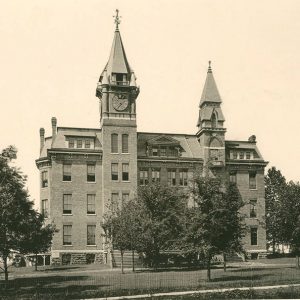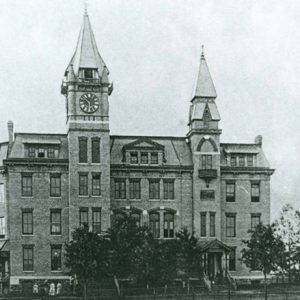calsfoundation@cals.org
Little Rock University
Little Rock University, founded in 1882, was the second college founded in Little Rock (Pulaski County) and the first of four colleges with “Little Rock” in the name. It was a four-year, liberal arts, coeducational school for white students. According to an Arkansas Gazette article, “The Little Rock University was built by the Freedman’s [sic] Aid Society, by the Arkansas Conference of the Methodist Episcopal Church, north, and the citizens of Little Rock who contributed $10,000 towards it.” The school closed in 1894.
The Freedmen’s Aid Society of the Methodist Episcopal Church, based in Cincinnati, Ohio, was formed in 1866. Its original purpose was “the relief and education of the Freedmen and people of color in general,” but the mission was later expanded to include promoting all education, including for white students, and its stated purpose was to promote Christian education of both black and white people in the South. The name was changed in 1888 to Freedmen’s Aid and Southern Education Society. It helped found or support segregated institutions throughout southern states, eventually listing thirty-three colleges, seminaries, and medical and dental institutions, including Philander Smith College in Little Rock, founded in 1877 by the Freedmen’s Bureau of the federal government as Walden Seminary.
The initiative for forming Little Rock University came through the efforts of the Reverend Dr. George W. Gray, a Methodist minister who came to Little Rock representing the society. He served as the first president of the institution. The eighteen-acre campus was established at a cost of approximately $50,000, including the $10,000 from the city.
A description of the campus stated: “This institution is beautifully situated….Its imposing structure of brick, surrounded by a fine campus, crowns University Hill on Lincoln Avenue, midway between the Depot and the river.” Another description stated: “Its main building was four stories high, the tower one-hundred-thirty feet high and the campus was on a bluff overlooking the river.” The campus location was described as both pleasant and healthful: “the grounds are 100 feet above the level of the Arkansas River flowing at their base, rendering malaria unknown.” The campus, which included a 1,000-volume library and a museum, was located just east of the site where Dillard’s Department Stores built its corporate headquarters a century later. The Oliver-Clayton House, adjacent to the west of the university building, was used for student housing.
The university offered BA and BS degrees. A post-graduate program for the Master of Arts degree qualified the institution for the title “university” rather than “college.” The first classes were held in 1882 in a downtown facility in the “Methodist block” between 4th and 5th Streets on Main. Classes on the new campus began in the fall term of 1883, and tuition was $15.00. “Substantial board was furnished to students at $2.50 per week.”
A published bulletin stated that the university planned to have seven colleges. In 1883, the College of Literature and Arts, the College of Music, and the College of Medicine were in operation. It was stated that “for the time being the Arkansas Medical College will represent the Medical Department.” The curriculum included a college preparatory course, a normal (teacher training) course, two biblical courses, English, Latin, Greek, French, and German. The society’s report in 1888 stated that there were 231 students and ten faculty members.
On June 18, 1884, the Arkansas Gazette reported that Gray had been removed as president and that Vice President F. S. Lewis had resigned. The newspaper was unable to find details of the conflict causing these departures. The article stated, “The Freedmen’s Aid Society furnished the principal part of the funds and retains control of the institution. Bishop Wiley of Cincinnati, president of the Freedmen’s Aid Society[,] and Dr. Rust, corresponding secretary[,] were in the city last week. They had a consultation with the board of trustees of the college and decided that its best interest would be subserved by the withdrawal of Dr. Gray, which was accordingly done, and when Professor Lewis sent in his resignation, it was accepted.”
Based on newspaper coverage of the various Little Rock University activities, including its controversies, there was much community interest and pride in the college. The school’s presence in Little Rock represented some consolation for Little Rock not having been chosen as the site for the state university, for which Fayetteville (Washington County) had been selected in 1871. Despite this early enthusiasm and success, however, in 1894 the school “was forced to suspend for want of patronage.” In 1896, the university announced its reopening, published a course catalog, and advertised in the Arkansas Methodist publication. This effort was unsuccessful, however, and the school closed permanently. From 1899 until 1905, the property was used as the Maddox Seminary for Young Ladies. It was used as a teaching hospital from 1906 until 1914. After being vacant for several years, it was damaged by fire, restored, and used for apartments. The building was demolished around 1960.
For additional information:
Atkinson, J. H. “The First Little Rock University.” Pulaski County Historical Review 14 (March 1966): 6–16.
Kennan, Clara B. “Little Rock University, First Edition” Pulaski County Historical Review 9 (March 1961): 12.
Roy, F. Hampton, Sr., Charles Witsell Jr., and Cheryl Griffith Nichols. How We Lived: Little Rock as an American City. Little Rock: August House, 1984.
Vernon, Walter. Methodism in Arkansas, 1816–1976. Little Rock: Joint Commission for the History of Arkansas Methodism, 1976.
“Without a Head.” Arkansas Gazette, June 18, 1884, p. 5.
W. W. Satterfield
Little Rock, Arkansas









Comments
No comments on this entry yet.